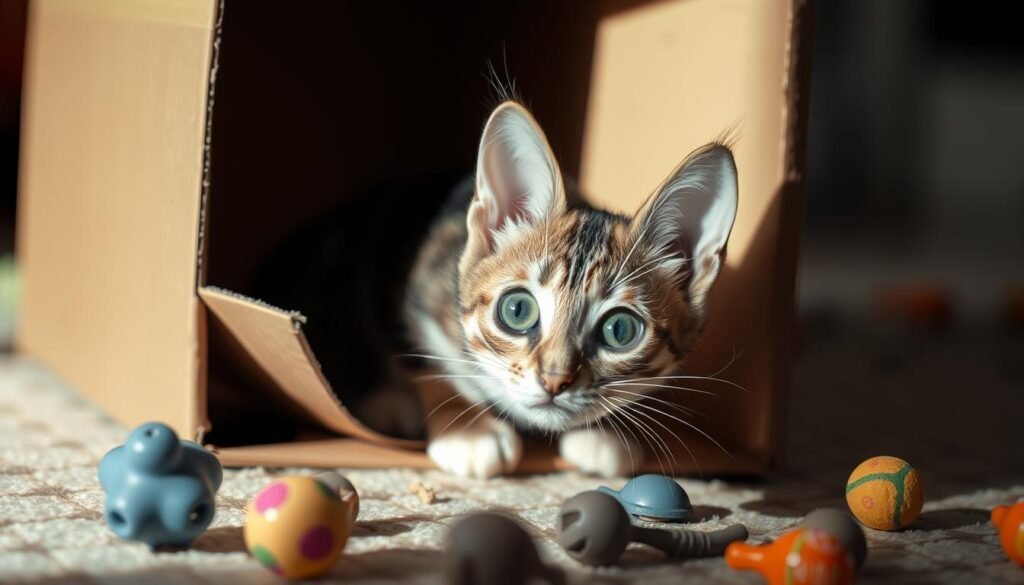Ever wondered why your cat loves a cardboard box more than a fancy cat tower? The secret is in their feline behavior and cat psychology. Get ready to learn why these simple boxes are so irresistible to them.

Why Cats Prefer Small Enclosed Spaces
Cats are curious and instinctive. Their feline instincts often lead them to seek small, enclosed spaces. These cozy nooks give them a sense of security and safety, like being swaddled.
By huddling in a confined area, cats can release endorphins. These hormones help reduce stress and induce a calming sensation.
Instinctive Desire for Safety and Security
Cats are natural predators but also have a strong security-seeking behavior. They prefer to rest and sleep in areas where they feel protected from potential threats. Small, enclosed spaces like cardboard boxes offer cats a sense of safety and control.
They can observe their surroundings without feeling exposed.
Similar to Being Swaddled, Releases Endorphins
The close contact with the interior of a box is believed to trigger the release of endorphins. These are the feel-good hormones that create a sense of pleasure and reduce stress. This comforting effect of confinement is similar to the calming experience of being swaddled.
“Cats spend up to 18 hours every day sleeping, and they find comfort and security in enclosed spaces like boxes.”
The Allure of Virtual Boxes
Cats are naturally drawn to enclosed spaces. This need for safety and security is not just for physical boxes. Even a “virtual box” can make them feel safe and in control.
Tape Squares on the Floor Provide Psychological Comfort
Research shows that a simple taped-off square on the floor can trigger the “virtual box effect.” Cats see these “tape squares” as real enclosures. They find comfort and security by sitting or standing in these imaginary spaces.
This “tape square experiment” has become a hit online. Videos of cats exploring their virtual territory are everywhere. It shows how strong the virtual box effect and psychological need for confinement are in cats, even without a real box.
“Cats are drawn to shapes on the ground, being instinctual for them to sit inside such shapes.”
The appeal of tape square experiments shows how cats interact with their world. It’s a mix of reality and their natural desire for virtual box effect and psychological need for confinement. Understanding this helps us see the complex bond between cats and their surroundings.
Boxes as Environmental Enrichment
Cardboard boxes can be a great source of fun for our cats. A study at Utrecht University in the Netherlands showed that cats in shelters felt less stressed with boxes. They found that cats with boxes were happier because they had a cozy place to hide.
Shelter Cats Adapted Better with Box Hideaways
About half of the cats with boxes explored their new home sooner. This led to lower stress levels compared to cats without boxes. Boxes give cats a sense of safety and comfort, especially in uncertain times. They help cats in shelters feel more at ease and happy in their temporary homes.
Boxes also help keep cats warm. They act as great insulators, keeping the cat’s body temperature stable. Cats need a warm environment, but most homes are cooler than what cats prefer.
It’s important to make cats’ environments engaging and enriching. Cardboard boxes are a simple yet effective way to do this. Understanding how boxes benefit cats allows us to provide better care, whether they’re in shelters or our own homes.
The Warmth and Insulation of Cardboard
Cats love to hide in cozy spots, and the cardboard box is perfect for them. The box’s insulation helps keep them warm. Cats prefer temperatures between 86 to 97 degrees Fahrenheit. Cardboard boxes help them stay warm, especially when it’s cold.
Studies show that shelter cats adjust faster with cardboard boxes. These boxes make them feel safe and reduce stress. At Utrecht University, cats felt comfortable in just 3 to 4 days with boxes, compared to 14 days without.
“Cats are attracted to boxes as they provide a sense of protection from unwanted attention and predators.”
Cardboard boxes offer more than just warmth. They also provide psychological comfort. This simple solution greatly improves a cat’s sense of safety and happiness.

Why Cats Love Cardboard Boxes
Cats have a strong attraction to cardboard boxes. It’s not just a passing fancy. Boxes meet their deep needs for security, comfort, and a place to show their hunting skills.
Simulating Hunting Environments and Ambush Behavior
When a cat hides in a box, it taps into their cat hunting instincts. They see the box as a hiding spot, perfect for sneaking up on prey. This behavior comes from their DNA, as cats are naturally stealthy hunters.
Boxes become their hunting ground. Here, cats can show off their hunting skills in a fun and mentally stimulating way.
“Cats often engage in predatory behaviors in boxes, satisfying their instinct to hide and pounce on prey even though they no longer need to hunt for survival.”
Boxes offer more than just safety. They let cats mimic the hunting environments they’d find in the wild. The enclosed space and the chance to watch their surroundings trigger their ambush behavior. It fulfills their natural hunting urge, even if they don’t need to hunt anymore.

Cats’ fascination with cardboard boxes comes from a combination of their natural instincts and domesticated life. When cat owners recognize this, they can better cater to their pets’ needs by creating stimulating and enriching spaces that cats truly enjoy.
New and Exciting Playgrounds for Cats
Cats love to explore and play, and cardboard boxes are perfect for them. These boxes offer cats many fun activities. They can play, scratch, and even mark their territory.
Cats sleep a lot, but when they’re up, they dive into box exploration. Cardboard boxes are like a playground for them. They can poke, prod, and even pounce on these boxes. Scratching the box also helps them sharpen their claws and mark their territory.
“Boxes view as magical portals that stimulate their imagination, encouraging curiosity and exploration.”
Cats are natural hunters, and boxes are great for their hunting play. They can climb up a box and then surprise their friends with a quick pounce. This play is important for their happiness and cardboard boxes are the perfect place for it.

Boxes as Cozy Beds
Cats love to sleep, with some sleeping up to 15 hours a day. They often choose small, enclosed spaces like cardboard boxes. These boxes give them a sense of security and comfort.
A Safe and Secure Sleeping Spot
Cats naturally seek safe, enclosed spaces for sleep. The tight box can make them feel secure, helping them sleep deeply. Cardboard boxes are also warm, which is good for cats’ body temperatures.
Having multiple boxes in a house with many cats can reduce stress. A cardboard box can be a comforting reminder of home when a cat moves. Make sure the box is safe by removing hazards and is the right size for the cat.
Adding pillows, blankets, or toys to the box can make it even more appealing. Cats are drawn to catnip but avoid citrus smells. These touches can make the box a cozy retreat for your cat.

Ensuring Box Safety for Cats
Cardboard boxes might seem like fun for our cats, but safety is key. As cat owners, we need to make sure our pets are safe and happy in these boxes. This means creating a cozy and safe space for them to play and rest.
Removing Hazards and Providing Soft Bedding
Before giving your cat a cardboard box, check it carefully. Look for things like staples, tape, or sharp edges that could hurt them. Also, add soft, comfortable bedding like a plush blanket to make it cozy.
Make sure the box is on a stable surface. This prevents it from tipping over and hurting your cat. By doing these simple steps, you can create a safe and secure haven for your cat to enjoy.

“Keeping our cats safe should always be our top priority, even when it comes to something as seemingly harmless as a cardboard box.”
The Science Behind Cat Attraction to Boxes
Cats love cardboard boxes, and it’s really interesting why. Psychology and behavior studies have found many reasons. These reasons make boxes so appealing to cats.
One big reason is the need for safety. Boxes make cats feel safe and hidden. This is because, in the wild, small spaces protected them from danger.
“Cats feel safer and shielded from predators in small, confined spaces like cardboard boxes.”
Boxes also remind cats of their kitten days. They feel warm and cozy, just like when they were young. This makes them feel happy and relaxed.

Boxes keep cats warm, which is great in cold weather. They feel snug and safe, just like when they were kittens. This is very comforting for them.
Cats also like small spaces because it’s good for their minds. It makes them feel less stressed and safer. Studies show that cats with boxes are happier and less stressed than those without.
In short, cats love boxes for many reasons. It’s a mix of instinct, psychology, and practical benefits. Boxes make cats feel safe, happy, and even help them feel like they’re hunting.
Purr-ting Thoughts
Cardboard boxes hold a special attraction for cats, providing them with a sense of safety and comfort. These boxes also help reduce their stress levels.
For cats, boxes are more than simple toys. They use them for hunting, sleeping, and adapting to new surroundings, highlighting how essential boxes are to their happiness.
Scientists are still researching the reasons behind cats’ fascination with boxes, but one thing is certain: boxes contribute to their overall well-being. Offering cats boxes leads to improved quality of life.
Understanding this attachment allows us to create better environments where cats can express their natural behaviors and thrive.
The cat-in-the-box phenomenon is fascinating, revealing the complexity of feline behavior. Observing their affinity for boxes gives us valuable insight into their lives and emotions.





